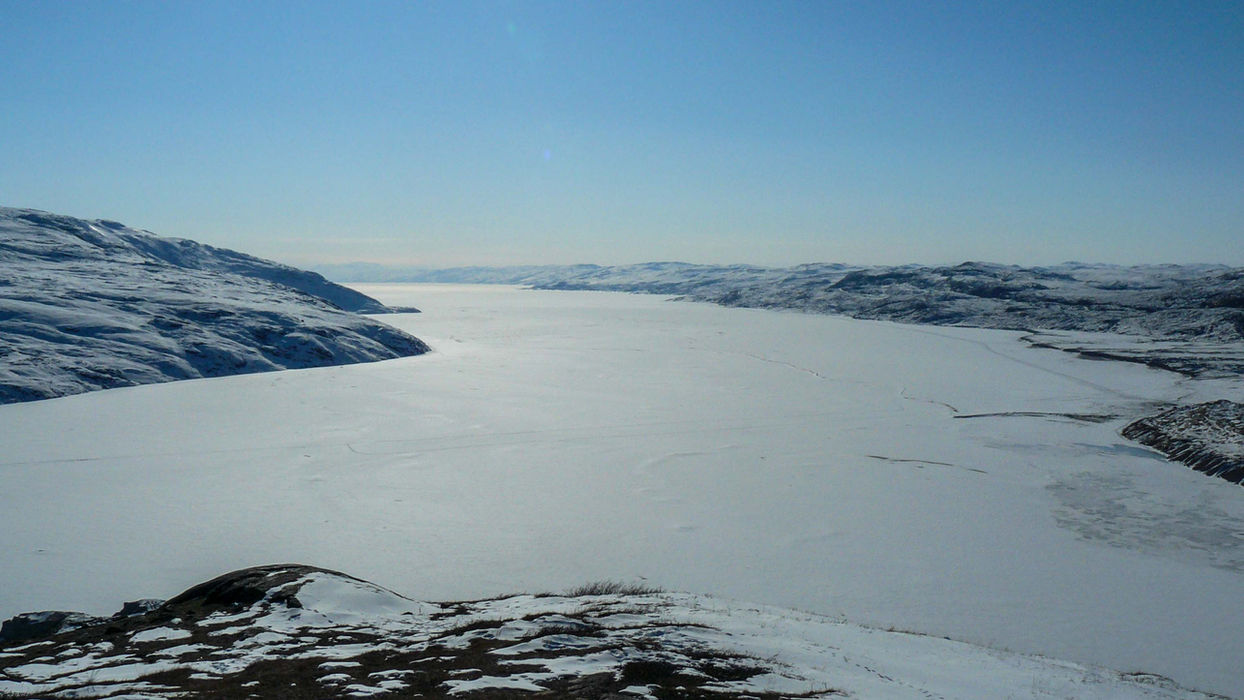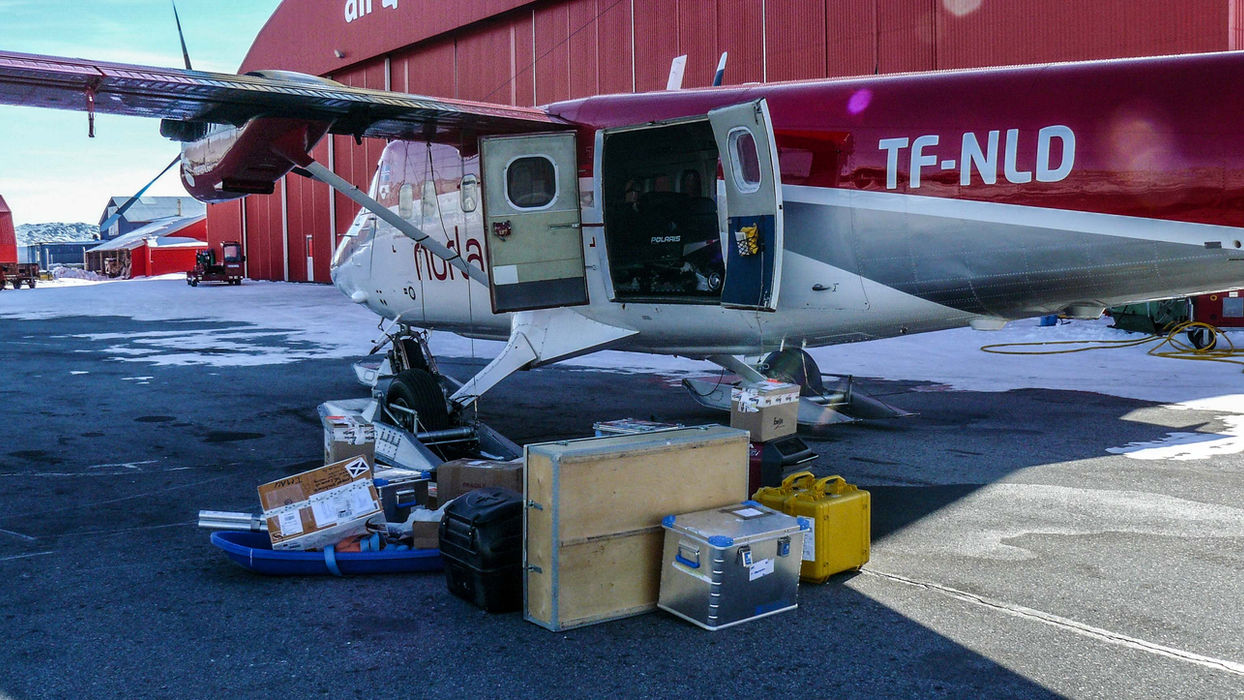
The coldest month
GREENLAND 2011

INTRODUCTION
March 2011
Discover the expedition
GREENLAND 2011
Copenhagen, Denmark
It seems that the biggest adventures of my life always started in a big city. I had just turned 23, and was keen to get more experience under my belt. After spending some weeks at home and in Svalbard that year, I was ready for more time in high latitude environment. I was reuniting with Sam Doyle, my teammate in the Himalayas, and then Dr. Alun Hubbard, my MSc coordinator at the university of Aberystwyth. And with that, two new colleagues from Sweden, Prof. Rickard Pettersson and his PhD students Katrin Lindback. Together we are aiming to spend 3 or 4 weeks on the ice sheet, on a glacier called Russel Glacier Catchment above 1000 m in altitude. Air Greenland took us to Kangerlussuaq on the west coast of the island, a real Arctic hub at the head of a "big fjord" of the same name.
We spent a few days there sorting out food, equipment, preparing our solar panels and research tools. I took over the little workshop at KISS, Kangerlussaq International Science Support, drilling, cutting, soldering, and cutting my hand in several places in trying to be quick. Sam was giving me lists of things to do every day, including my favorite mission "go for walk" ;)
TO THE ICE
The flight was incredible. The ice sheet looked a lot more heterogeneous than I had imagined. There were giant crevasse fields, hills, troughs, the first ice sheet I ever saw and worked on.
"Welcome to hell" said Sam as soon as we landed. And indeed, it was. At least during the first week. We started our expedition in the middle of a cold anomaly. While other polar institutes were getting their researchers off the ice, we were getting our little camp set up. For the first few days, we had to dig, dig dig dig. I always say that glaciologists are first and foremost Dr. in digging, and this was no exception. We were coming back to a site that Alun Hubbard and his team had been using for a few years, in the accumulation zone of the ice sheet. Accumulation means snowfall, and indeed the boxes, tents, overcraft for the previous years were buried deep in snow. This was the perfect strategy to keep us warm so we never complained about digging! We were particularly happy when we found the alcohol stock and the snacks.
In the little tent I was sharing with Katrin, we had placed a mini thermometer. When I was lying in my sleeping bag I had my eyes glued to the thermometer, crossing the -35°c threshold, then -40°c and eventually -44°c. This was inside the tent! When I said I was not prepared, it was mostly because my equipment could survive a balmy -20°c at the lowest, not -44°c. We all struggled so much with these temperatures. Our equipment was breaking, our bodies were suffering, every day was a battle against the cold.
And in the middle of this cold wave, we had to do some science! Our expedition was a part of the Greenland Analogue Project, our mission was to focus on the hydrology of the ice sheet. For this, 4 main goals:
- servicing existing weather stations
- installing GPS
- burying seismometers
- do a lot of radar and hope to detect some subglacial lakes
During our time at KISS we bumped into two skiers who had both their hands wrapped like boxers. They had just been evacuated from the ice during their crossing of the ice sheet, and a sudden drop of temperature caught them at the worst moment, freezing the several pairs of gloves they had and their fingers... We spent the rest of the day buying every pair of gloves we could find in town, deeply scared about the things to come. This was my first big polar expedition, and I was not quite ready for it.
It took us three twin otter flights to bring all of us and our kit on the ice. The main problem was fitting a snowmobile in the plane, which requires a lot of Tetris skills. The D day had come, finally, ice time.
The cold wave had a massive impact on our work. A polar expedition is always a race against time, and indeed, spending days and night fixing our broken equipment was not ideal. When the weather improved a bit, we decided to focus all our efforts on the radar, with one team working 12 H during the "night" and the second team working during the day shift. At that time, we were only four people left, my tentmate Katrin had to leave on a resupply flight. I lobbied to be a part of the day shift with Rickard and got my request approved by the rest of the team :)
Doing radar in Greenland consisted in dragging a 200 m long line of fiber optic cables with a snowmobile at 5 to 10 km per hour. One person had to drive the scooter of course, and a second one was in charge of the computer, sitting on a little sled 100 m behind the snowmobile. This was by far the coldest position of the job, with no way to stay warm or to shelter. This was when I developed many different ways to stay warm on this tiny stool, boxing the air, doing squats and dreaming of warmer days.
Radaring is also the best way to get a feel of the terrain, to observe, detect tiny changes in the slope, texture and density of the ice and the snow. More than once we found ourselves in the middle of gigantic and terrifying crevasse fields that required some delicate driving to get out of there asap while still collect great data. Sam also took me on shorter missions to fix weather stations, install GPS and the seismometers or find super moulins away from camp. This expedition was really a baptism by fire for me, I learnt some of the most important lessons of my life.
LAST DAYS ON THE ICE
By this point, after more than 3 weeks on the ice, we were getting pretty knackered. Our faces were frostbitten, our hands full of cuts, I even remember my nail detaching from my fingers and toes because of the cold, it was so painful we had to tape them back against our skin. It was time to go home! We all agreed for one last push, 36 H of work to pack up the camp, and radar our way back to the meeting place with the twin otter. Our plan was to send Alun and Sam ahead, to make the trail, and have Rickard and I at the back, collecting radar data. Driving such a big distance while being so sleep deprived was quite the experience. I could see Sam falling asleep while driving, I had to keep singing/screaming to stay alert and awake.
Eventually, 36H later, we could finally see a structure on the horizon. The base of Dye 2, a geodesic dome built in the late 1950s as an early warning system. The little dot was growing bigger and bigger on the horizon. Suddenly, I look behind me and see a huge hercules plane about to land exactly where we were! At that point I wasn't sure if I was deeply hallucinating or if the plane was real, we made a sharp turn to avoid the plane. We realised that we were driving on a snow runway, made to train american pilots to land and take off on snow. Arriving at Dye 2 was such a relief. We had survived to this expedition, with all our fingers and toes, and collected great data. I was looking forward to going home and giving my body a good rest.
I don't remember anything about the flight back, only that it felt warm and safe in the plane, making us all fall asleep. As soon as we landed in Kangerlussaq we kept sleeping on the tarmac, absolutely exhausted. The next morning, I was mentally prepared for a few days of drying/packing equipment and go home. This is precisely when Alun asked me how I would feel about spending another 2 weeks in Greenland. No matter how broken I was, I'm always keen for more adventures! I was happy to keep working with Sam, and discover more of the surroundings.
FROM ONE ADVENTURE TO THE NEXT
This new adventure was a lot shorter than our time on the ice sheet. Our goal: to service one GPS base station near point 66 at the margin of Russel glacier, and try to find the corresponding GPS on the ice, a few kilometers in land. Little did we know how crazy this adventure turned out to be. First of all, we left Kangerlussuaq on bikes, which was a great way to lower our carbon footprint! On the way to the glacier, a cohort of nice SUVs drove passed us, like 20 or 30 cars, in the middle of nowhere. We had heard rumors that the prince of the Netherlands, Willem Alexander, might come to the same location as us, and this turned out to be correct!
As soon as we arrived on site, the secret services aka a man we called "James Bond" stopped us and was really wondering what two scruffy youngsters were doing in the area. After pretty cold introductions, James Bond became our BFF and helped us a lot with our fieldwork. We even got to be invited to join their fabulous dinner one evening, prepared by some of the best chefs of the country and of Denmark. Certainly a nice change from our chinese noodles and dry tech.
Our biggest challenge was to retrieve a GPS some 8 ish kilometers inland, on the ice. Sam invited Roderick, another glaciologist who was taking part in the delegation of the prince, to join us. Sam usually goes to the GPS using a helicoper, this was the first time he tried on foot. And no doubt the last! After a few hours of walking we found ourselves surrounded by deep deep crevasses, with snow bridges collapsing all over the place. We all had a sinking feeling that things could go wrong very quickly. We were running out of water, running out of time, and the GPS station was still kilometers away. After a lot of negotiating we all agreed to save our energy to make it safely back to camp instead of pushing hard into the crevassy maze.
James Bond came to pick us up after this unending day on the ice, and drove like a mad man back to camp. He admitted that he was a bit worried about us! Sam and I decided to have one last night in the field, and cycle back to town the next morning. We could not miss our shot, I was supposed to take the plane back to Denmark the next morning. To increase our efficiency, we packed up the tent and slept only in our sleeping bags outside. We woke up covered in frost and snow, with all our equipment completely frozen. Not the simplest commute to the airport! I made it just in time, even saw Michel Rocard at the airport (our french Ambassador for the polar regions at the time), and spent a few days hugging trees back in Copenhagen.
The end of a crazy adventure! Big thanks to Prof. Alun Hubbard, Dr. Sam Doyle, Prof. Rickard Pettersson and Dr. Katrin Lindback!




































